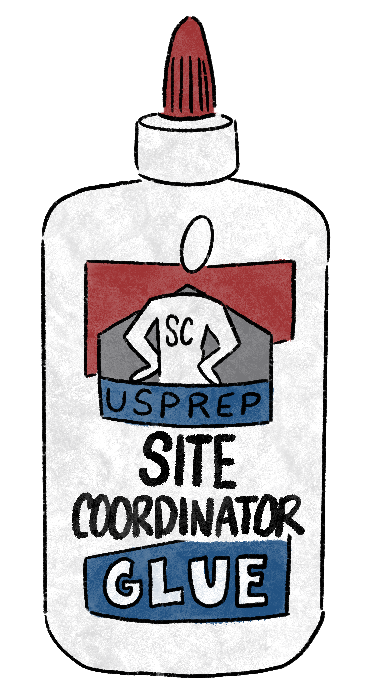The linchpin is an individual who can walk into chaos and create order, someone who can invent, connect, create, and make things happen. Every worthwhile institution has indispensable people who make differences like these.
― Seth Godin
What is a Site Coordinator?
US PREP has found that in order to ensure strong, mutually beneficial university-school partnerships and high-quality clinical experiences at scale, educator preparation programs need to think strategically about their staffing models. Traditionally, colleges of education allocate most of their resources to the higher education campus (e.g. research, coursework, etc.). Part-time adjunct faculty supervisors typically supervise the clinical experiences but are not responsible for leading partnership meetings, selecting and training mentor teachers, or teaching classes. Further, many programs do not offer support and training to their supervisors which can result in variable levels of coaching quality and observation ratings. Because the supervisors do not teach teacher preparation courses, they often aren’t aware of the skills and competencies that are being taught and therefore may not be as capable of supporting the transfer of learning to the field. Many of the faculty don’t know who the supervisors are – and vice-versa, supervisors don’t know the faculty. Oftentimes, this model results in a disconnected training experience for the residents.
In US PREP, educator preparation programs commit to redesigning their staffing models to include site coordinators. Site coordinators are full-time faculty members who support residents during their clinical experiences, working on-site at schools to train mentors, supervise residents, and shape coursework based on the needs of the district’s students. Their role combines practice-based instruction in one or more university courses, along with the hands-on guidance that both residents and their mentor teachers receive. This deep collaboration with district and school leaders helps to make university-district partnerships successful at scale.
The Site Coordinator is the program’s connector, core advocate and developer of candidates, and the brand ambassador in PK-12 schools.
A Site Coordinator is:
- A member of the university faculty who evaluates residents and teaches courses (student teaching seminars & methods)
- Conducts walkthrough observations, formal observations, and coaching of residents
- Trained and calibrated on the resident evaluation tool
- Have demonstrated proficient coaching practices
- Facilitates observation tool norming
- Embedded within the district (with relationships with administration and mentor teachers)
- Plans/facilitates data-driven, quarterly mentor trainings and ongoing mentor meetings and support
- Plans/facilitates data-driven, quarterly governance meetings
- Attends university meetings and programs, including faculty meetings and professional development, as appropriate
Approaches to Adopting the Role
Click below to learn how other EPPs shifted to ensure the implementation of the high-quality model via the Site Coordinator
Scaling the Site Coordinator Role
Read our recent publication,
"Scaling the Site Coordinator," highlighting multiple case studies on this critical role.
Pause and Process
Pause and Process
At the end of each section of the US PREP Scale Toolkit we will ask a few brief questions for you to consider on your journey. Once you have completed all the Pause and Process Sections, we will send you your answers via email so you can see your results.
We encourage you to keep your results and share them with your US PREP scaling partner.





